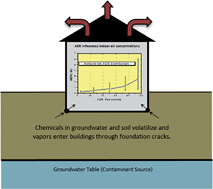US residential building air exchange rates: new perspectives to improve decision making at vapor intrusion sites
Abstract
Vapor intrusion (VI) is well-known to be difficult to characterize because indoor air (IA) concentrations exhibit considerable temporal and spatial variability in homes throughout impacted communities. To overcome this and other limitations, most VI science has focused on subsurface processes; however there is a need to understand the role of aboveground processes, especially building operation, in the context of VI exposure risks. This tutorial review focuses on building air exchange rates (AERs) and provides a review of literature related building AERs to inform decision making at VI sites. Commonly referenced AER values used by VI regulators and practitioners do not account for the variability in AER values that have been published in indoor air quality studies. The information presented herein highlights that seasonal differences, short-term weather conditions, home age and air conditioning status, which are well known to influence AERs, are also likely to influence IA concentrations at VI sites. Results of a 3D VI model in combination with relevant AER values reveal that IA concentrations can vary more than one order of magnitude due to air conditioning status and one order of magnitude due to house age. Collectively, the data presented strongly support the need to consider AERs when making decisions at VI sites.


 Please wait while we load your content...
Please wait while we load your content...